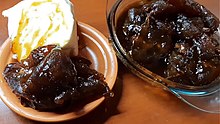Kosereva
Kosereva is a common "barreled" candy with a high protein content originally made in Paraguay, made with the hardened skin of the sour orange[1] ("apepú", in Guaraní language) and cooked in black molasses, resulting in a bittersweet and acidic taste. The name "koserevá" comes from the Guaranitical derivation of the Spanish word "conserva" (preserved food). Historical records state that Spanish conquerors that came to Paraguay during the colonial ages used to preserve this citric fruit by cooking them in trimmed barrels in black molasses.
 | |
| Type | Confectionery |
|---|---|
| Place of origin | Paraguay |
| Main ingredients | Pintonas (ripe sour oranges), sugar, molasses, water |
Ingredients
Preparing typical koserevá requires only sour oranges "pintonas" (ripe sour oranges), sugar, molasses and abundant water.
gollark: Any fatal compile runtime errors would then be Resulted into warning returns by the prelude.
gollark: The Macron runtime compiler would take the AOT-compiled Macron assembly and JIT it into WASM, which would then be compiled into Macron bytecode.
gollark: Oh yes, of course.
gollark: Would Macron spontaneously make the `random` call compile-time?
gollark: Although possibly not technically identical.
See also
References
- "Paraguay, the Country of Cassava." Consumer.es. Accessed July 2011. (in Spanish)
- “Tembi’u Paraguay” Josefina Velilla de Aquino
- “Karú rekó – Antropología culinaria paraguaya”, Margarita Miró Ibars
External links
- Paraguay, the Country of Cassava (article) (in Spanish)
This article is issued from Wikipedia. The text is licensed under Creative Commons - Attribution - Sharealike. Additional terms may apply for the media files.